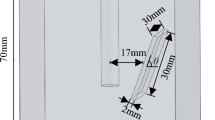Abstract
The pre-crack blast technology has been used to control the induction caving area in the roof. The key is to form the pre-crack seam and predict the effect of the seam. The H-J-C blast model was built in the roof. Based on the theories of dynamic strength and failure criterion of dynamic rock, the rock dynamic damage and the evolution of pre-crack seam were simulated by the tensile damage and shear failure of the model. According to the actual situation of No. 92 ore body test stope at Tongkeng Mine, the formation process of the pre-crack blast seam was simulated by Ansys/Ls-dyna software, the pre-crack seam was inspected by a system of digital panoramic borehole camera. The pre-crack seam was inspected by the system of digital panoramic borehole in the roof. The results of the numerical simulation and inspection show that in the line of centers of pre-hole, the minimum of the tensile stress reaches 20 MPa, which is much larger than 13.7 MPa of the dynamic tensile strength of rock. The minimum particle vibration velocity reaches 50 cm/s, which is greater than 30–40 cm/s of the allowable vibration velocity. It is demonstrated that the rock is destroyed near the center line and the pre-crack is successfully formed by the large diameters and large distances pre-crack holes in the roof.
Similar content being viewed by others
References
CHARLIE C L. Disturbance of mining operation to deep underground workshop [J]. Tunneling and Underground Space Technology, 2006, 21(1): 1–8.
MIAO Sheng-jun, LAI Xing-ping, CUI Feng. Top coal flows in an excavation disturbed zone of high section top coal caving of an extremely steep and thick seam [J]. Mining Science and Technology, 2011, 21(1): 99–105. (in Chinese)
HU Jian-hua, LEI Tao, ZHOU Ke-ping, CHEN Qing-fa. Effect of blasting vibration on pre-splitting crack in filling-environment [J]. Journal of Central South University and Technology (Science and Technology), 2011, 42(6): 1704–1709. (in Chinese)
REZA N. Prediction of ground vibration level induced by blasting at different rock units [J]. International Journal of Rock Mechanics and Mining Sciences, 2011, 48(6): 899–908.
BROWN E T. Block caving geomechanics [M]. Australia: Julius Kruttschnitt Mineral Research Centre, 2003: 3–12.
HU Jian-hua, ZHOU Ke-ping, LI Xi-bing, SU Jian-hong, YANG Nian-ge. Numerical analysis of application for induction caving roof [J]. Journal of Central South University of Technology, 2005, 12(Supp. 1): 146–149. (in Chinese)
GU De-sheng, LI Xi-bing. Modern mining science and technology of metal deposits [M]. Beijing: Meturllegical Technology Press, 2006: 531–558. (in Chinese)
REN Feng-yu, HAN Zhi-yong, ZHAO Ren-ping, WANG Wei-jie. Induced caving technique and its application in beiminghe iron mine [J]. Mining Research and Development, 2007, 27(1): 17–19. (in Chinese)
HU Jian-hua, SU Jia-hong, ZHOU Ke-ping. Evaluation and time-varying mechanical numerical analysis to induction caving roof [C]// Progress in Mining Science and Safety Technology, Pts A and B. Beijing: Science Press, 2007: 48–54.
GUO Wang, ZHOU Ke-ping, HU Jian-hua. Numerical simulation of time-varying effect to induction caving roof based on RFPA 2D [C]// 2010 2nd International Conference on Computer Engineering and Technology. Chengdu: IEEE Computer Society, 2010: 1152–1155.
HU Jian-hua, SU Jia-hong, ZHOU Ke-ping ZHANG Shi-chao, GU De-sheng. Time-varying numerical analysis of mode in induction caving roof [J]. Rock and Soil Mechanics, 2008, 29(4): 931–936. (in Chinese)
CHEN Qing-kai, ZHU Wan-cheng. Mechanism of the crack formation induced by pre-split blasting and design method for the pre-split blasting hole space [J]. Journal of Northeastern University (Natural Science), 2011, 32(7): 1024–1027. (in Chinese)
WANG Fang-tian, TU Shi-hao, YUAN Yong, FENG Yu-feng, CHEN Fang, TU Hong-sheng. Deep-hole pre-split blasting mechanism and its application for controlled roof caving in shallow depth seams [J]. International Journal of Rock Mechanics and Mining Sciences, 2013, 64(4): 112–121.
ZHU W C, WEI C H, LI S, WEI J, ZHANG M S. Numerical modeling on destress blasting in coal seam for enhancing gas drainage [J]. International Journal of Rock Mechanics and Mining Sciences, 2013, 65(10): 179–190.
YANG Xiao-lin, WANG Shu-ren. Meso mechanism of damage and fracture on rock blasting [J]. Explosion and Shock Waves, 2000, 20(3): 247–252.
LI Y P, CHEN L Z, WANG Y H. Experimental research on pre-cracked marble under compression [J]. International Journal of Solids and Structures, 2005, 42(9/10): 2505–2516.
PEI Jian-liang, LIU Jian-feng, XU Jin. Experimental study of mechanical properties of layered marble under unloading condition [J]. Chinese Journal of Rock Mechanics and Engineering, 2009, 28(12): 2496–2502.
ZHOU Hua, WANG Guo-jin FU Shao-jun. Finite element analysis of foundation unloading and relaxation effects of xiaowan arch dam [J]. Rock and Soil Mechanics, 2009, 30(4): 1175–1180.
LI Dong-hai, LIU Jun, NIU Xiao-kai. Research on vertical deformation of down shotcrete tunnel during unloading of pit excavation. [J]. Rock and Soil Mechanics, 2009, 30(2): 563–571.
QIAN Qi-hu, WANG Ming-yang. Impact and explosion effect in rock and soil [M]. Beijing: National Defence Industry Press, 2010: 126–155.
Livermore Software Technology Corporation. LS-DYNA Theoretical Manual [M]. Livermore Software Technology Corporation, 1998
TAO Ming, LI Xi-bing, LI Di-yuan. Rock failure induced by dynamic unloading under 3D stress state [J]. Theoretical and Applied Fracture Mechanics, 2013 (65): 47–54.
HU Jian-hua, ZHOU Ke-ping, LUO Xian-wei. Panoramic inspection and evaluation of blasting effect of induction caving roof [J]. Rock and Soil Mechanics, 2010, 31(5): 1529–1533.
Author information
Authors and Affiliations
Corresponding author
Additional information
Foundation item: Project(2006BAB02A02) supported by the National Key Technology R&D Program for the 11th Five-year Plan of China; Project (09JJ4025) supported by the National Natural Science Foundation of Hunan Province, China; Project(51074178) supported by the National Natural Science Foundation of China
Rights and permissions
About this article
Cite this article
Hu, Jh., Lei, T., Zhou, Kp. et al. Mechanism on simulation and experiment of pre-crack seam formation in stope roof. J. Cent. South Univ. 21, 1526–1533 (2014). https://doi.org/10.1007/s11771-014-2093-2
Received:
Accepted:
Published:
Issue Date:
DOI: https://doi.org/10.1007/s11771-014-2093-2




